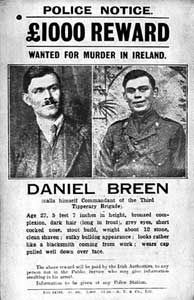20 January 2005 Edition
The Soloheadbeg ambush - Remembering the Past

On 21 January 1919, 86 years ago, the 3rd Tipperary Brigade of the IRA fired the opening salvo of the Tan War in Soloheadbeg.
Information had reached the Third Brigade in December 1918 that explosives were being transported in their area and they began preparations to seize these much needed munitions. Lar Breen, a brother of Dan, was sent to work in a local quarry to gather intelligence. He confirmed that a delivery was expected around 16 January but the exact date and route couldn't be confirmed. The Volunteers organised a small tin hut as a base for their attack on the convoy; there they sent out spotters and waited day after day for word that the convoy was on its way.
Those involved on the day of the operation were four officers of the 3rd Tipperary Brigade IRA; Seán Treacy, Dan Breen, Seán Hogan (then only 17) and Séamus Robinson. They were joined by five other Volunteers: Tadhg Crowe, Mick McCormack, Paddy O'Dwyer (Hollyford), Michael Ryan (Donohill) and Seán O'Meara (Tipperary) — the latter two being cycle scouts.
Robinson, who participated in the 1916 Rising, was the organiser and Treacy, a member of the Irish Republican Brotherhood since 1911, was the logistics expert.
In their planning, Treacy and the others were unsure of the size of the police contingent which would be guarding the gelignite and made preparations for various contingencies, including a guard of up to 12 RIC men. Tadhg Crowe was to guard the policemen when they were captured, while Paddy Dwyer was the lookout who was to follow the convoy from Tipperary Town.
Finally, after five days of surveillance, Paddy Dwyer saw the explosives, 160 pounds of gelignite, being loaded on a cart and heading off with a guard of two RIC men. He cycled ahead and watched as they took the long route to the Soloheadbeg quarry. He took the short route and informed the anxious Volunteers of the convoy's size and movements. The horse was being led by two workmen, Edward Godfrey and Patrick Flynn, while the two policemen, Constables Patrick MacDonnell and James O'Connell, walked behind with their carbines slung over their shoulders.
As they passed Cranitch's Field near the quarry, the RIC men were twice called on to surrender by the masked IRA Volunteers who had positioned themselves on the side of the road in a ditch. When the RIC men shouldered their carbines and took up firing positions Seán Treacy, followed by Breen and Robinson, opened fire with .22 automatic Mauser rifles and an automatic Colt.
Leaving the two RIC men dead on the road, the IRA men hurried to take the horse and cart out of the area. They left the two civilians alone but had they searched Patrick MacDonnell they would have found 30 electric detonators in his pocket. The IRA men then hid the gelignite by the side of the Dundrum-Tipperary Road. The horse and cart and two sticks of gelignite were dropped at another location to throw the crown forces off the scent. One week later, with massive searches continuing in the area and the risk of the munitions being discovered at any time, Tom Carew (who was later to be made IO of the 3rd Brigade) decided to move the hoard to a safe arms dump. With his brother he procured two carts laden with timber and drove out to where the IRA men had left the boxes of gelignite. They loaded these onto the driver's seat and drove away. On the way to where they would dump the gelignite they were stopped by the RIC. The RIC questioned the cool headed Carew for 20 minutes but suspected nothing. Eventually they let him go, warning him that he shouldn't be driving around with no lights on as it was dangerous.
The Volunteers who had taken part in the raid then went on the run. GHQ was anxious that those involved would go to the US until the situation calmed down, but the Volunteers refused. Seán Treacy said "any fool can shoot a peeler and run away to America''. Instead, he asked that a Proclamation directing all British troops to leave Ireland be issued. Condemnation for the killings was swift and from every quarter, even from some local republicans.
It wasn't until April 1921 that Dáil Éireann, at Erskine Childers' bidding, formally declared hostilities against Britain.
Tipperary was declared a "special military area" and all fairs and markets were banned. Military reinforcements were rushed in and a major hunt was on for the IRA men. A reward of £1,000 was increased to £10,000, but to no avail. The men remained on the run and they all saw regular action in the subsequent war, some making the supreme sacrifice for Ireland's freedom.
As with other ambushes of the time the sole purpose of the ambush in Soloheadbeg was the capture of explosives. An order curtailing military style operations from the IRA GHQ meant no major operation occurred for a few months after Soloheadbeg. The official newspaper of the Volunteers, An tÓglach, took a different line, stating ten days after Soloheadbeg that Volunteers could use "all legitimate methods of warfare against the soldiers and policemen of the English usurper, and to slay them if necessary to overcome their resistance''.
The gelignite lay where Carew had hidden it by a stream in Golden Garden until November 1919, when it was retrieved and distributed as follows; one case to HQ South Tipperary Brigade, one case to Tipperary Town Battalion and one to the Rosegreen area. The first use made of it was in an attack on Drumbane Hall in January 1920, almost a year to the day from its capture at Soloheadbeg.


